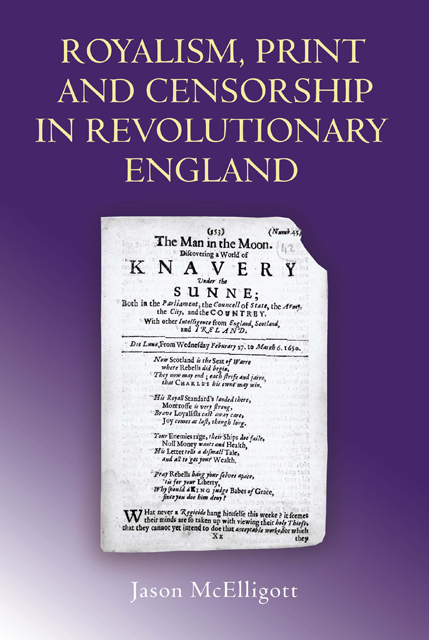Book contents
- Frontmatter
- Contents
- Illustrations
- Acknowledgements
- Abbreviations
- Introduction: Royalism and its Problems
- 1 Royalists and Polemic in the 1640s
- 2 The Politics of Sexual Libel
- 3 The Twists and Turns of Royalist Propaganda
- 4 Authors, Shifting Allegiances and the Nature of Royalism
- 5 Printers, Publishers and the Royalist Underground
- 6 Hunting the Royalist Press
- 7 The Theory and Practice of Censorship
- 8 A New Model of Press Censorship
- Conclusion
- Select Bibliography
- Index
7 - The Theory and Practice of Censorship
Published online by Cambridge University Press: 10 March 2023
- Frontmatter
- Contents
- Illustrations
- Acknowledgements
- Abbreviations
- Introduction: Royalism and its Problems
- 1 Royalists and Polemic in the 1640s
- 2 The Politics of Sexual Libel
- 3 The Twists and Turns of Royalist Propaganda
- 4 Authors, Shifting Allegiances and the Nature of Royalism
- 5 Printers, Publishers and the Royalist Underground
- 6 Hunting the Royalist Press
- 7 The Theory and Practice of Censorship
- 8 A New Model of Press Censorship
- Conclusion
- Select Bibliography
- Index
Summary
Strong and effective censorship?
Until relatively recently it was generally thought that the early-modern English state exerted such a strict control over what was written and printed that the system of censorship could be likened to that of modern totalitarian states. The most important exponent of this idea was Frederick Siebert, whose highly influential (and staunchly Whig) Freedom of the Press in England, 1476–1776 first appeared in the United States at the height of the Cold War in 1952. Siebert likened government control of the press in early-modern England to that in Communist Russia, and for him it was axiomatic that successive governments had wished to control or suppress anything which interfered with or undermined their authority, and the struggle between this oppressive state apparatus and the brave men who risked life and limb to publish political and religious truth played a central part in the emergence of a free, prosperous and democratic society in Britain. Siebert's account of early-modern censorship influenced numerous scholars over several generations, among whom perhaps the most prominent figure was the Marxist historian Christopher Hill. He believed that Tudor and Stuart control over the press was tantamount to modern attempts at ‘thought-control’, and the strict control of the press was, he wrote, designed to ‘prevent the circulation of dangerous ideas among the masses of the population’. To Hill, although censorship was omnipresent before 1640, the strictness of the system increased during the 1630s and reached its zenith following the promulgation of a decree by the infamous Court of Star Chamber in 1637. When this imposing edifice collapsed in 1641 it ‘opened the floodgates’ on a wealth of hitherto suppressed radical literature which was only brought under control with great difficulty during the 1650s. This brief period of freedom was so frightening that one of the first things that the restored monarchy did in 1660 was to reinstate a strict control of the press. For both Siebert and Hill, one of the keystones of the edifice of censorship was the Stationers’ Company, the joint-stock company incorporated byRoyal Charter in 1557, and which exerted a fearsome and diligent control over the output of the press.
- Type
- Chapter
- Information
- Royalism, Print and Censorship in Revolutionary England , pp. 183 - 209Publisher: Boydell & BrewerPrint publication year: 2007
- 1
- Cited by

